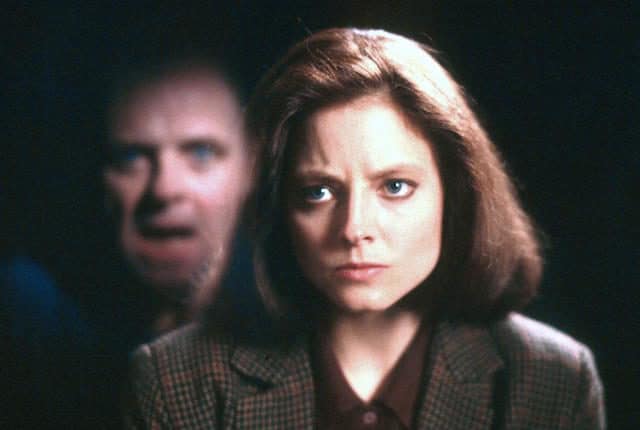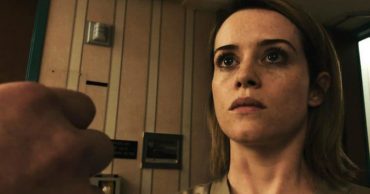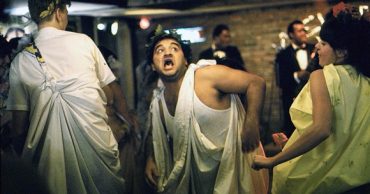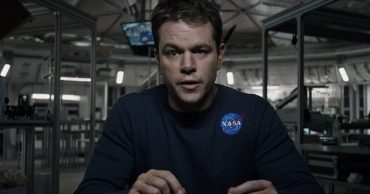
What would the world be like without the movie psychological thriller genre? For one thing, it would take a lot of the fun out of watching movies. What makes psychological thrillers one of my favorite movie genres is because I don’t particularly care for the horror/slasher movies (though you might place a couple on this list in that category).
After compiling the list I noticed that we usually think of psychological duels going on between people, particularly men and women in relationships, no matter how creepy those relationships may be. More than half of the movies that made the list involve two people, but there are also psychological duels between man and machine, man and animal, and man against “the system.” The conflicts that we watch sometimes have eerie connections to our own lives, while others we can easily relate to.
The “hook” in a psychological thriller is making the connection personal. So that must mean your personal choices of “best” psychological thrillers is an open analysis of what is going on in your own mind. On the other hand, a movie like Silence of the Lambs is on the vast majority of people’s favorite psychological thriller lists, so what does that say about the national psyche?
Here is the list, in no particular order, though just to be different I am making the numbers 1, 3, 4, 9, and 14 as always deserving of inclusion on anyone’s Top 20 list. Beyond ranking the movies, I injected possibilities where the movies could have had a sequel or they missed the potential to explore another dimension of the characters.
1. Silence of the Lambs
One of the few films to win all five major Academy Award categories, this movie Hannibal Lecter constantly working to psychologically outduel the world at large and the FBI specifically. Though there is clearly a psychological duel between Lecter and Agent Starling, he doesn’t seem to be intent on wining the duel as he does in simply engaging in the duel. This idea shows up later in Hannibal but when he says at the end that the world is a more interesting place with Starling in it, it may reveal a weakness of Lecter that gives Starling the upper hand in the long run. Unfortunately, the franchise never seems to explore this dimension of the relationship between the two. Still, this is one of the great psychological thrillers of all time.
2. Law Abiding Citizen
If you are like me, you really thought the ending was a downer. The movie deserved a better ending, though I guess they couldn’t let the bad guy get away. There are definitely points where you are cheering for the bad guy Clyde Shelton because deep down you know after watching the opening scene that his revenge motive is highly justified. The movie plays out a moral and legal dilemma that most people can easily relate to. Many people say that Shelton was a serial killer because of the body count he racks up, but his target isn’t District Attorney Nick Rice but the justice system as a whole. Though Rice doesn’t end up being a casualty, everyone around him in the legal system from wardens to judges, to defense attorneys, to fellow inmates are all collateral damage. Back to the ending, if they would have scripted in a way for him to avoid prosecution (another deal?) they could have had a sequel where his target went beyond the city.
3. Primal Fear
This was Ed Norton’s breakout movie, playing Aaron (who according to Aaron really never existed) as the accused murderer of a revered Catholic bishop. It touches on the idea of who we really are at our most primal level, and the things we do to cover up the things that we fear the most about our basest instincts. There is no way that you are looking sympathetically at Aaron, and the truth is you want to see him punished. But like many excellent psychological thriller characters, Aaron ends up playing the system against itself, manipulating it to his advantage. As one reviewer points out, this movie is paced fast enough so you don’t get bogged down in too many details, and it is the pace that really give you time to think about everything that is going on. The ending is hard to improve on.
4. Fatal Attraction
If you have ever heard the phrase “bunny boiler” in reference to a woman, you need to give credit to this movie for the phrase. It is (or was) used more commonly in England to describe a woman who is mentally unstable and dangerously vengeful. The basic storyline is simple: married man meets single, unstable woman who he has a fling with but she won’t let go. But Alex, the spurned woman, is extremely aggressive in making her point she will not be just pushed to the side. It is a movie about obsession on a scale new to movie audiences in the 1980’s (it can be argued that there are a number of bunny boilers in real life now). There are two endings to the movie, and this is one of those movies where fans are divided on which of the endings best fits the storyline. Whichever ending you decide is better, this is a movie that had to end — no sequel possible.
5. Cape Fear
When does a convicted felon have the advantage over the legal system that prosecuted him? When the ex-con is tough, intelligent, and scheming enough to play havoc with those who prosecuted and defended him. This movie is more of a commentary on the public defender system that the legal system as a whole, but with Robert de Niro playing convicted rapist Max Cody it turns into a psychological thriller. Cody does not seem intent on simply executing a revenge killing on his former public defender Sam Bowden. He wants to psychologically torture him — and there are no boundaries to his plan. Bowden’s family is fair game, and with his wife and teenage daughter as vulnerable targets, Cady has a clear upper hand. Cady is another guy you don’t feel sorry for no matter how Bowden resolves the dilemma.
6. Falling Down
When this movie first hit the box office, Time magazine wrote a cover article on it titled “White Male Paranoia.” In some ways it can be considered a movie relevant to the economic shifts going on in America in the 1980’s. But oddly, it might be just as relevant today with a few minor changes. At first, the movie looks like a string of common cultural complaints about the state of America — overpriced food, divorce and child custody, crime and violence, unemployment. Then you realize that all of these issues are points on a road map for William Foster’s quest to visit his daughter on her birthday and give her a gift. That innocent visit has been prohibited by a court order, and ex-wifey Beth seems to have good reason to be paranoid about him. In some ways Foster is a hero, making a social commentary (though with a cache of weapons) that most people agreed with in the 80’s, and probably today. But he is just edgy enough to make you realize not all is well. If you believe he is a victim of the culture, ask the question so often heard on the old Cops TV series: “Why did you run?”
7. The Manchurian Candidate
There is a 1962 version of the film that lays the foundation for the modernized 2004 version, which is my preference. The 1962 version focuses on a soldier that comes back from the Korean War; the 2004 version uses the Persian Gulf War as the backdrop. The storyline is that there are people in the military who have been programmed to carry out instructions through the famous technique of brainwashing, programmed to kill a powerful political target. Beyond the psychological aspect of the possibility, the viewer wonders if the person who is programmed will ever figure out that they have been programmed. And of course the end of both movies has you wondering whether or not such people actually exist in the world today.
8. The Bone Collector
This is one of those films that some people may categorize as a horror film since there is plenty of unique and horrific way. Another criticism of the movie is the acting was not particularly good. But sometimes the storyline and better than average directing can overcome some major flaws. Denzel Washington plays his role from a specially designed bed equipped to help him deal with his paralysis (not much action there). Angelina Jolie plays Amelia Donaghy who is the one that gets most of the action, following Washington’s directions on evaluating clues as she tracks down a serial killer. While the methods of execution of the victims are sometimes creative, the psychology is whether it is possible to stop the murders from happening. The time and the place of the murders are known, so the question is whether the serial killer can be outwitted.
9. The Exorcist
This movie ends up many lists as THE greatest horror movie of all-time. One of the scenes that was not possible to include in the 1973 original was the famous spider walk, which was included in the 2000 upgrade of the movie as they removed the wires using CGI. The psychology part of the movie is something that doesn’t resonate as commonly with today’s audiences as those in the 70’s. It is a morality story, with clear distinctions between good and evil. Today’s paranormal movies lean more towards grey areas of good and evil in both the storyline and the characters. But when you think about it, most psychological thrillers force you to choose between good and evil — however you define them. If you haven’t seen the movie yet, be sure to get the upgraded version because the TV versions are usually sanitized to some degree.
10. One Flew Over the Cuckoo’s Nest
I had to choose between this one and Jack Nicholson’s The Shining. While The Shining has a crazier Jack, One Flew Over the Cuckoo’s Nest is actually set in a psychiatric hospital. Can there be a more appropriate setting? Louise Fletcher (Nurse Ratched) is superb as she is the stoic and creepily serene contrast to the hospital inmates, all who have one type of problem or another. It is clear why some people are there, and others have you wondering why they were even considered, such as Nicholson’s character, R. P. McMurphy. Then there is the sink, which represents the imprisonment that no one can escape. McMurphy is smart enough to know how the system is gaming the inmates, but in the end the system imposes its will on him, which in 1975 was a warning to us all.
11. Play Misty for Me
We usually see Clint Eastwood blasting away with his .44 magnum at the bad guys, but in this movie as Dave Garver he plays a guy at the wrong end of an obsessive relationship. For many men even today it is the thing they fear the most — how to get rid of a woman who is stalking you. (Yes, I realize it is trendy today for men to stalk women, but after all it’s the 1970’s and it is Clint). Being the 1970’s the stalking isn’t done through texting or social media, but by phone calls and personal “visits” to his home by stalker Evelyn, played by Jessica Walker. This movie can be seen as Fatal Attraction with a different motive — to kill the stalkee.
12. Insomnia
Though Good Morning, Vietnam is seen as a breakthrough movie for the late comedian Robin Williams, Insomnia has him shed his comedy routine to play murderer Walter Funch. Pairing with Al Pacino and Hillary Swank didn’t hurt his performance. Funch is always one step ahead of his pursuers, even when tantalizing close. But Detective Will Dormer (Pacino) has more to worry about than catching Funch as he is dealing with his own set of inner demons after his partner’s murder. The underlying theme here is knowing, but not being able to do anything about it. Most of us have been there, and it is frustrating not only trying to find the answer but having to live a normal life in the meantime. For Funch, it is simply a game of “catch me if you can” which only adds to Dormer’s frustration.
13. Jaws
Some people classify this as a horror movie, but if you choose not to, then exactly what type of movie do you classify it as? It’s not sci-fi and drama seems to be a weak choice. Psychological thriller fits if — and only if — you look at it as a battle between the shark and Quint (Robert Shaw). There are definite ties to Moby Dick in the movie as well to Quint’s experience as a sailor aboard the U.S.S. Indianapolis. Revenge is a huge factor for Quint, and while there is enough blood and gore to suggest a horror movie, the over the top reactions by Quint in pursuit of the shark end up being his undoing. His story about his experiences as a sailor aboard the Indianapolis (superbly told) end up being eerily prophetic if you pay close attention.
https://www.youtube.com/watch?v=0IrNq74pdqk
14. Ex Machina
This was a surprise summer hit in 2014, and for good reason. The “futuristic robots” theme had been tackled before in a variety of ways, but Ex Machina did it by keeping things simple and letting the audience consider the possibilities. One of the amazing things about this movie is if you see the ending (the last 3 and a half minutes) it only wants to make you find out how it got to that point. More of the movie is spent on how humans interact with robots than the other way around. For some people parts of it may be hard to follow because there are times when you can get lost for a bit in the technical jargon used in the dialog. But just keep watching because almost everything makes sense at the end — to the robots.
15. Basic Instinct
I know, I know. The popular talk about this movie is the Sharon Stone scene where she gives men an upskirt shot. But the movie itself is one of the best psychological thrillers because Stone’s character, Katherine Tramell, has her outwitting detectives by playing on their male weaknesses. That talked about upskirt scene takes place during an interrogation by no less than 5 detectives. The scene emphasizes the fact that she can win the psychological battle of the sexes by remaining calm and being honest enough to feed into the basic instinct of men. Their weakness is her strength, and as long as she lets the men play “chase” she will always avoid being caught. An impressive performance by Sharon Stone, though somewhat lurid for some people’s taste.
16. 2001: A Space Odyssey
If you ask someone who watched this movie who the central character was, you are likely to get the answer, “Hal.” Hal is the computer that actually is the star of the movie (quick, who are the two astronauts?) as it is a mind game between machine and man. The movie starts off being very cryptic, and makes the viewer think about what it all means (a psychological game by director Stanley Kubrick?).The movie, released in the 1960’s prompted a lot of questions but was not willing to cross the line and end it with Hal winning the battle of the minds. But it is clear during the movie that Hal really never lost the battle of the minds — they just caused Hal to lose its memory. They could try and remake the movie and modernize the technology, giving Hal an even greater advantage. And audiences would not be surprised if the movie ended with Hal winning.
17. Psycho
When you talk about psychological thriller movies you must include the name Alfred Hitchcock. Psycho is so well known that giving a description or basic storyline is almost insulting to the reader. The shower scene is among the most famous in all of movie history, and the basic Norman Bates character has been used in many slasher-type movies. What separates this from slasher movies is Hitchcock’s presentation of horror sans blood and gore. The audience knows what is happening because one of Hitchcock’s techniques was to allow the viewer to see the action as though they were really there. It is correct to call it voyeuristic but in a non-sexual way. The shower scene is one of the best examples of this, and why it remains a classic film clip.
18. Rear Window
This is one of the lesser known of Hitchcock’s many films but still popular nevertheless. Insomnia (#12) was about knowing and not being able to do anything about it. Here, Hitchcock created suspense by withholding information from the audience. But Rear Window illustrated how to do it masterfully. An audience can become quickly frustrated if they don’t know what is going on (too much information is withheld) so has to be given just enough information to keep them guessing — and watching. Even movies out of the psychological thriller genre have mastered this, but none as good as Hitchcock does here.
https://www.youtube.com/watch?v=1Zzg3UP-x8k
19. Misery
Actress Kathy Bates got rave reviews for her performance in this movie, earning the Oscar for Best Actress in a Leading Role. And for good reason. Playing a nurse who helps an award winning writer involved in an accident, she turns into a psychopath after finding out the writer will be killing off one of her favorite characters in his latest book. She really loves him and his writing, but love can have its consequences. She goes over the edge because in her mind she has betrayed her by penning the character’s death, even though she calls herself his number one fan. It is a line that he will never forget.
20. The Game
We all love games because regardless of the type of game they give us a break from reality. But as more than a few serious video game players know, sometimes it gets hard to distinguish reality from the virtual world. This is the ongoing dilemma for Nicholas Van Orton, played by Michael Douglas, in the movie. He gets an invitation from his brother to participate in a unique entertainment service as a gift for his 48th birthday. What follows after accepting the invite has him wondering what side is up in his real life — or perceived real life. This movie isn’t responsible for coining the phrase “perception is reality” but it definitely could have.
 Follow Us
Follow Us





